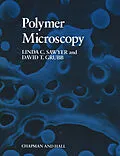Modern materials include a vast array of polymers and plastics which are found in applications such as housing, appliances, clothing and household textiles and automotive and aerospace industries. Thus research scientists, engineers and materials science graduate students need to be aware of the methods and techniques required to understand the structure-property relations of polymer materials. This book will review the field of the microscopy of polymers. There is a vast literature which describes the research results obtained by study of polymer materials using microscopy and other complementary analytical techniques and such studies are best left to journals on specific topics. The major objective of this text is to provide the basic microscopy techniques and specimen preparation methods applicable to polymers. The book will attempt to provide enough detail so that the methods described can be applied, and also to reference appropriate publications for the investigator interested in more detail. The selection of two authors for this text came from the desire for a comprehen sive review of polymer microscopy with emphasis on methods and techniques, rather than on research results. The synergism provided by two authors with widely varied backgrounds was thought to be important: one author (LCS) has an industrial focus and a background in chemistry whilst the other (DTG) has an academic environment and offers a background in polymer physics.
Inhalt
1 Introduction to polymer morphology.- 1.1 Polymer materials.- 1.1.1 Introduction.- 1.1.2 Definitions.- 1.2 Polymer morphology.- 1.2.1 Amorphous polymers.- 1.2.2 Semicrystalline polymers.- 1.2.3 Liquid crystalline polymers.- 1.3 Polymer processes.- 1.3.1 Extrusion of fibers and films.- 1.3.2 Extrusion and molding.- 1.4 Polymer characterization.- 1.4.1 General techniques.- 1.4.2 Microscopy techniques.- 1.4.3 Specimen preparation methods.- 1.4.4 Applications of microscopy to polymers.- 2 Fundamentals of microscopy.- 2.1 Introduction.- 2.1.1 Lenses in the microscope.- 2.2 Optical microscopy.- 2.2.1 Introduction.- 2.2.2 Objective lenses.- 2.2.3 Imaging modes.- 2.2.4 Measurement of refractive index.- 2.2.5 Polarized light.- 2.3 Scanning electron microscopy (SEM).- 2.3.1 Introduction.- 2.3.2 Imaging signals.- 2.3.3 SEM optimization.- 2.4 Transmission electron microscopy (TEM).- 2.4.1 Imaging modes.- 2.4.2 Diffraction techniques.- 2.4.3 Phase contrast and lattice imaging.- 2.5 Microscopy of radiation sensitive materials.- 2.5.1 SEM operation.- 2.5.2 Low dose TEM operation.- 2.6 Analytical microscopy.- 2.6.1 X-ray microanalysis.- 2.6.2 X-ray analysis in the SEM vs. AEM.- 2.6.3 Elemental mapping.- 2.7 Quantitative microscopy.- 2.7.1 Stereology and image analysis.- 2.7.2 Calibration.- 2.7.3 Image processing.- 2.8 Dynamic microscopy.- 2.8.1 Stages for dynamic microscopy.- 3 Imaging theory.- 3.1 Imaging with lenses.- 3.1.1 Basic optics.- 3.1.2 Resolution.- 3.1.3 Electron diffraction.- 3.1.4 Contrast mechanisms.- 3.1.5 Illumination systems.- 3.2 Imaging by scanning.- 3.2.1 Scanning optics.- 3.2.2 Beam-specimen interactions.- 3.3 Polarizing microscopy.- 3.3.1 Polarized light.- 3.3.2 Anisotropic materials.- 3.3.3 Polarizing microscopy.- 3.4 Radiation effects.- 3.4.1 Effect of radiation on polymers.- 3.4.2 Radiation doses and specimen heating.- 3.4.3 Effects of radiation damage on the image.- 3.4.4 Noise limited resolution.- 3.4.5 Image processing.- 4 Specimen preparation methods.- 4.1 Simple preparation methods.- 4.1.1 Optical preparations.- 4.1.2 SEM preparations.- 4.1.3 TEM preparations.- 4.2 Polishing.- 4.2.1 Polishing artifacts.- 4.2.2 Polishing specimen surfaces.- 4.3 Microtomy.- 4.3.1 Peelback of fibers/films for SEM.- 4.3.2 Sections for OM.- 4.3.3 Sections for SEM.- 4.3.4 Ultrathin sectioning.- 4.3.5 Ultrathin cryosectioning.- 4.4 Staining.- 4.4.1 Introduction.- 4.4.2 Osmium tetroxide.- 4.4.3 Ebonite.- 4.4.4 Chlorosulfonic acid.- 4.4.5 Phosphotungstic acid.- 4.4.6 Ruthenium tetroxide.- 4.4.7 Silver sulfide.- 4.4.8 Mercuric trifluoroacetate.- 4.4.9 Iodine.- 4.4.10 Summary.- 4.5 Etching.- 4.5.1 Introduction.- 4.5.2 Plasma and ion etching.- 4.5.3 Solvent and chemical etching.- 4.5.4 Acid etching.- 4.5.5 Summary.- 4.6 Replication.- 4.6.1 Simple replicas.- 4.6.2 Replication for TEM.- 4.7 Conductive coatings.- 4.7.1 Coating devices.- 4.7.2 Coatings for TEM.- 4.7.3 Coatings for SEM.- 4.7.4 Artifacts.- 4.7.5 Gold decoration.- 4.8 Yielding and fracture.- 4.8.1 Fractography.- 4.8.2 Fracture: standard physical testing.- 4.8.3 In situ deformation.- 4.8.4 Crazing.- 4.9 Freezing and drying methods.- 4.9.1 Simple freezing methods.- 4.9.2 Freeze drying.- 4.9.3 Critical point drying.- 4.9.4 Freeze fracture-etching.- 5 Polymer applications.- 5.1 Fibers.- 5.1.1 Introduction.- 5.1.2 Textile fibers.- 5.1.3 Problem solving applications.- 5.1.4 Industrial fibers.- 5.2 Films and membranes.- 5.2.1 Introduction.- 5.2.2 Model studies.- 5.2.3 Industrial films.- 5.2.4 Flat film membranes.- 5.2.5 Hollow fiber membranes.- 5.3 Engineering resins and plastics.- 5.3.1 Introduction.- 5.3.2 Extrudates and molded parts.- 5.3.3 Multiphase polymers.- 5.3.4 Failure analysis.- 5.4 Composites.- 5.4.1 Introduction.- 5.4.2 Composite characterization.- 5.4.3 Fiber composites.- 5.4.4 Particle filled composites.- 5.4.5 Carbon black filled rubber.- 5.5 Emulsions and adhesives.- 5.5.1 Introduction.- 5.5.2 Latexes.- 5.5.3 Wettability.- 5.5.4 Adhesives and adhesion.- 5.6 Liquid crystalline polymers.- 5.6.1 Introduction.- 5.6.2 Optical textures.- 5.6.3 Solid state structures.- 5.6.4 High modulus fibers.- 6 Problem solving summary.- 6.1 Where to start.- 6.1.1 Problem solving protocol.- 6.1.2 Polymer structures.- 6.2 Instrumental techniques.- 6.2.1 Comparison of techniques.- 6.2.2 Optical techniques.- 6.2.3 SEM techniques.- 6.2.4 TEM techniques.- 6.2.5 STEM techniques.- 6.2.6 Technique selection.- 6.3 Interpretation.- 6.3.1 Artifacts.- 6.3.2 Summary.- 6.4 Supporting characterizations.- 6.4.1 X-ray diffraction.- 6.4.2 Thermal analysis.- 6.4.3 Spectroscopy.- 6.4.4 Scattering.- 6.4.5 Summary.- Appendixes.- Appendix I Abbreviations of polymer names.- Appendix II List of acronyms - techniques.- Appendix III Manmade polymeric fibers.- Appendix IV Common commercial polymers and tradenames for plastics, films and engineering resins.- Appendix V General suppliers of EM accessories.- Appendix VI Suppliers of optical and electron microscopes.- Appendix VII Suppliers of x-ray microanalysis equipment.
